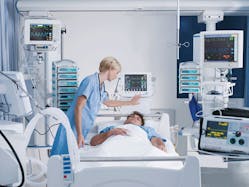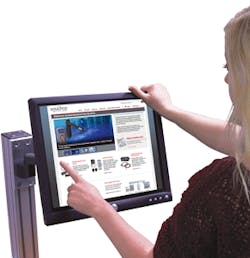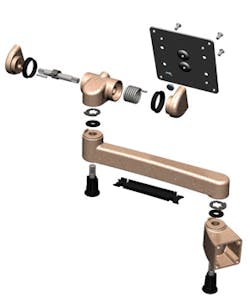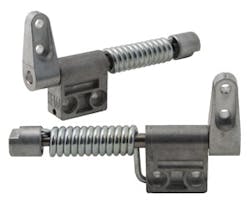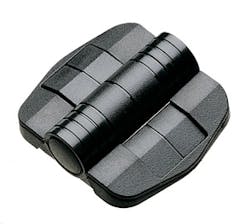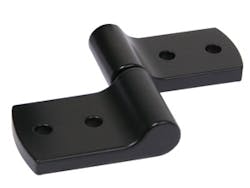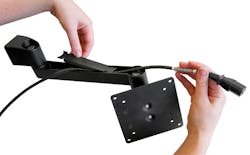To deliver easier-to-use, more-portable diagnostic and treatment devices, biomedical engineers often incorporate large flat-screen and tablet-sized displays, as well as touchscreen controls. However, adding such enhancements can’t be done at the last minute. Designers must ensure the displays, controls, and mounting hardware keep patients, health-care workers, and maintenance personnel safe, and enhance rather than hinder the machine’s primary functions (see "Human Factors Engineering Influences Medical Equipment Design"). Meanwhile, manufacturers must guarantee compliance with changing medical-design standards to avoid recall and warranty issues.
One way to meet these goals is to use mounting hardware and positioning arms designed with constant-torque components. For example, they can be used to offset the weight of a heavy screen, provide a more ergonomic, intuitive experience for operators, or ensure mobile devices are secure while being transported around a facility.
Ergonomic challenges and misses
Ultimately, ergonomic design should be “invisible” to users so there are no frustrations or major learning curves for individuals operating the equipment. It also simplifies operations and minimizes operator physical strain during use.
For mounting arms and hardware, ergonomics translates into being easy to position, requiring low force to operate (see "Display-Mount Possibilities"). Ergonomics also encourages correct body positioning on the part of users to avoid repetitive strain injuries and being able to adjust to a range of user physical characteristics and behaviors. For example, a seated or standing person should be able to use the equipment.
Unfortunately, many display mounts and positioning arms do not live up to these goals. For example, many positioning arms let operators swing them into position, but there’s nothing to hold them in place. When the operator lets go, the arm retracts, forcing users to constantly readjust it. Some arms come with locking levers, but these levers may require more than one step to adjust or they may be locked down so tightly that operators may not even realize they are adjustable, and thus don’t bother to try. Other arms are saddled with complicated adjustment settings. They often end up being damaged by well-intentioned health-care professionals and patients who don’t know how to use them.
Many display mounts have tilt features that let users adjust the up-and-down angle of the screen to accommodate user height or lighting conditions. Too many of them do not hold position as they wear or age, and the screens drift down to their original position. Users adapt by adjusting themselves to the screen, rather than positioning the screen to suit their preferences.
Mounting hardware should balance two conflicting needs: the ability to reposition the screen, controls, or equipment easily, yet remain in that position when someone adjusts the controls or uses the touchscreen. On top of that, the hardware should be intuitive and easy to use. In short, moving the equipment should be seamless, with effortless, one-touch positioning.
Newer challenges involve the portability of medical equipment, letting it be used in different rooms, even on different floors, of a clinic or medical office. This means once-stationary equipment must now handle the dynamic loads associated with moving from one location to another. In general, portability demands light, smaller equipment that can be properly secured for transport.
This file type includes high resolution graphics and schematics when applicable.
Constant torque
Constant-torque components in mounting applications can overcome several of these ergonomic hurdles. They apply friction that continuously resists motion, but only take a measured amount of force — a simple touch or gentle push — to permit movement.
Constant-torque joints in hinges and display mounts are based around hardened alloy shafts. The shafts are gripped by hardened-steel, torque-generating elements lubricated to generate a narrow range of torque for tens of thousands of motion cycles without additional lubrication or adjustment. The initial lubrication ensures low wear rates. With this construction, the joint or mount can reliably develop high torques in a limited space over the course of a lengthy service life. Properly designed and manufactured constant-torque hinges should last the life of the mount or hinge without maintenance.
From an ergonomic standpoint, constant-torque components let designers precisely control operating forces for joints where relative motion exists between two parts. Key benefits of constant-torque-designed arms and mounts include:
• Lets users position screens, controls, and equipment with one hand. There should be no need to hold the screen with one hand and position it with the other.
• Prevents drift without adding complicated and hard-to-use locking levers. This keeps equipment in place during use and when it’s moved from one room to another.
Constant-torque hardware can improve a variety of medical equipment, such as wall-charting stations, medical cabinets, and diagnostic equipment, with heavy lids by making them easier and simpler to open and close. For heavier lids and displays, engineers could add counterbalancing springs. Counterbalanced springs can hold the lid or cabinet wide open, or in any intermediate position, while someone uses them.
For the wall-mounted charting station, for example, constant-torque hinges let nurses adjust the angle of the keyboard rest. The hinges’ torque provides enough resistance so that the force of typing won’t move the keyboard rest. Also, when outfitting hinges with a “breakaway” function, the hinge breaks away rather than bending or breaking from an excessive load, such as when a nurse overloads the keyboard by falling on it, or by dropping a heavy package on it.
Hinges can be designed with different torque options. Counterbalanced hinges, for instance, let nurses raise heavy objects, such as metal lids or X-ray arms, with minimal force, reducing back and shoulder strain. Another option—the detent hinge—has a spring-loaded, hardened-steel ball that pops into pockets at specific opening angles, locking the hinge in place in predetermined positions. However, motion is smooth and unimpeded between detent positions. Designers control the force necessary to take the hinge out of a detent by using stronger or weaker springs.
Withstanding the medical environment
Ergonomic hardware mounts and arms for medical equipment must also be designed for the risks commonly associated with health-care facilities. That includes exposure to everything from cleaning products and chemicals to temperature change, UV radiation, and potential biohazards, as well as accidents. The mounts and exposed hardware should have minimal seams, creases, and knobs for easy cleaning and to deny hiding places for bacteria and dirt. Finishes should be tested to ensure they withstand intended environments without fading or discoloring. Powder-coat finishes are often applied because they can be formulated to resist UV rays or may contain antimicrobial ingredients that prevent bacterial growth.
Positioning arms and hinges must accept the weight of equipment being carried. They must also handle loads from patients and staff leaning against the display, as well as bumps and shocks experienced during transport.
Essentially, the industry standard for display mounts is that they support a minimum of four times the display’s weight without catastrophic failure. Many hospital and clinics go beyond the standard, requiring mounts hold six to eight times the display’s weight—and these are just the starting point. In addition, designers need to consider forces above and beyond normal operation. They must anticipate someone hanging something heavy on the arm or actually falling onto it.
Another vulnerable part of newer touchscreen controls and LCD displays concerns wiring and cabling. Wire-management devices built into positioning arms and mounts protect wires from damage and simplify installation. Built-in wire-management features should not be too complex or require technicians to disassemble equipment. If wire management is not simple, staff may try to “help” by tying wires to the outside of the arm — not the best idea. Protecting the cables, preferably out of sight, ensures they are kept clean, safe during transport, and simple to replace when upgrading or repairing devices.
Typically, wire-management devices are not sterilized because the electronics cannot withstand it. In many cases, healthcare workers just put disposable, sterile bags over the wires if needed.
Wire management can be approached in several ways:
• Wires attached to the outside of the arm exterior: The simplest option and easy to replace, but it’s not attractive and wires are not protected.
• Partially concealed wires: Most of the wire gets tucked inside the arm with a cover holding it into place. The only exposed wire runs between the wall plug and the end of the arm, and the other end of the arm and monitor. It looks much better, and the wires are protected and easy to replace. It also facilitates cleaning the arm.
• All wires inside the arm: Though cables are completely protected, they’re all bent on a tighter radius, risking more stress on the wires and potentially accelerating wear. Additionally, arms must have more space to accommodate the wire, making them larger and more costly. Threading wires through the joints can turn into a time-consuming process, as well.
Off-the-shelf advantage
Using proven, off-the-shelf components to mount or support medical displays and equipment brings several advantages over custom components.
For example, custom parts need to be tested early in the design process to keep development on schedule and ensure the end product is effective, safe, and easily operated by end users. However, testing can be extensive and costly.
Case in point: An adjustable swing arm that will support a large-screen display must go through cycle testing. This involves moving the arm through every possible motion. Therefore, putting an arm through 20,000 cycles—while loaded with the heaviest possible display it could carry—requires building dedicated test equipment. To simulate real-life operation, cycle speeds are limited to prevent overheating, so a typical cycle might be around 15 seconds. This translates to 3.5 days of 24/7 testing, which gets multiplied by the number of samples lined up for testing. This means it will take several months of test time. And if the arm fails during testing, the engineering team faces weeks of redesign, followed by more testing.
By opting for an off-the-shelf arm that meets spec requirements, however, the supplier takes ownership if the product falls short of specifications. Plus, the supplier will have done most, if not all, of the needed cycle-testing.
Engineers and designers should still work closely with suppliers to ensure the final device correctly incorporates the proper components so as not to lower product specifications or compromise performance. Off-the-shelf components dramatically reduce risk because they usually possess a track record of proven performance in similar application.
Resources:

